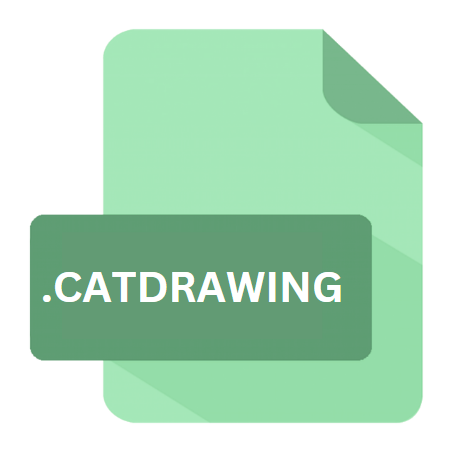.CATDRAWING File Extension

CATIA V5 Drawing
| Developer | Dassault Systemes |
| Popularity | |
| Category | CAD Files |
| Format | .CATDRAWING |
| Cross Platform | Update Soon |
What is an CATDRAWING file?
The .CATDRAWING file extension is a vital component of the CATIA V5 software suite, developed by Dassault Systèmes.
This file format is used for creating and storing 2D drawing representations of 3D models designed in CATIA V5, one of the most prominent CAD (Computer-Aided Design) software used in various industries such as aerospace, automotive, and industrial machinery.
The .CATDRAWING files enable engineers and designers to produce detailed technical drawings that are essential for manufacturing and documentation purposes.
More Information.
The CATIA software suite, and consequently the .CATDRAWING file extension, originated to meet the complex design requirements of the aerospace industry.
Dassault Aviation needed a more advanced and integrated design tool to streamline the design and manufacturing process of aircraft. This need led to the development of CATIA, which soon expanded its capabilities to other industries.
The .CATDRAWING file format was introduced with CATIA V5, which was released in 1998. The purpose of this file format was to facilitate the creation of precise and standardized 2D drawings derived from 3D models created within the CATIA environment.
These drawings include detailed dimensions, annotations, and other necessary information that assist in the manufacturing and quality assurance processes.
Origin Of This File.
The .CATDRAWING file extension is intrinsically linked to CATIA (Computer Aided Three-dimensional Interactive Application), a multi-platform software suite for CAD, CAM (Computer-Aided Manufacturing), CAE (Computer-Aided Engineering), 3D modeling, and PLM (Product Lifecycle Management).
CATIA was initially developed in the late 1970s and early 1980s by Dassault Systèmes, a French software company, in collaboration with the aerospace company Avions Marcel Dassault.
File Structure Technical Specification.
The .CATDRAWING file format is proprietary and structured to encapsulate a wealth of information required for technical drawings. Here’s a closer look at its key technical specifications:
- Vector-based Graphics: .CATDRAWING files primarily store vector-based graphics, which ensure that the drawings are scalable without losing quality. This is crucial for maintaining the accuracy of dimensions and annotations.
- Layers and Views: The file supports multiple layers and views, allowing users to organize different aspects of the drawing (such as dimensions, annotations, and different views of the model) separately. This organization enhances clarity and manageability.
- Embedded Metadata: These files can contain metadata that includes information about the drawing such as author, creation date, modification history, and other pertinent details.
- Integration with 3D Models: .CATDRAWING files are closely integrated with the 3D models (.CATPart and .CATProduct files) created in CATIA. Changes in the 3D model can be reflected in the 2D drawings, ensuring consistency and accuracy.
How to Convert the File?
Converting .CATDRAWING files to other formats can be necessary for sharing with stakeholders who do not use CATIA V5. Here are some common conversion methods:
- Using CATIA V5: CATIA V5 itself provides options to export .CATDRAWING files to various formats such as PDF, DXF, DWG, and others. This is the most straightforward method, ensuring fidelity to the original drawing.
- Third-Party Tools: Several third-party tools and plugins are available that can convert .CATDRAWING files to other formats. Examples include CAD converters like CrossManager, which supports a wide range of CAD formats.
- Online Conversion Services: Some online services offer CAD file conversion capabilities, though they may have limitations in terms of file size and complexity.
Advantages And Disadvantages.
Advantages:
- High Precision: .CATDRAWING files allow for high-precision drawings, which are essential in fields requiring exact specifications.
- Scalability: The vector-based nature of the files ensures that drawings can be scaled without loss of detail or quality.
- Integration: Seamless integration with 3D models in CATIA allows for easy updates and consistency between 3D designs and 2D drawings.
- Industry Standard: Widely used in industries such as aerospace, automotive, and manufacturing, making it a standard format for technical drawings in these sectors.
Disadvantages:
- Proprietary Format: As a proprietary format, .CATDRAWING files can only be fully utilized within the CATIA environment, limiting interoperability with other CAD software.
- Cost: CATIA is an expensive software suite, which can be a barrier for small businesses or individual users.
- Complexity: The sophistication and complexity of the software can pose a steep learning curve for new users.
How to Open CATDRAWING?
Open In Windows
- CATIA V5: The native and most comprehensive tool for opening and editing .CATDRAWING files on Windows.
- Viewer Applications: Tools like eDrawings Viewer and EnSuite-View can open .CATDRAWING files for viewing purposes, though editing capabilities will be limited or non-existent.
- CAD Converters: Software like CrossManager can convert .CATDRAWING files to more universally accepted formats.
Open In Linux
- Wine: Wine can sometimes be used to run Windows applications on Linux, including CATIA V5, although this is not officially supported and may have limitations.
- Virtual Machines: Running Windows in a virtual machine on Linux to use CATIA V5.
- CAD Viewers and Converters: Linux users can rely on CAD viewers and converters that support multiple platforms.
Open In MAC
- Virtual Machines or Boot Camp: Since CATIA V5 is primarily designed for Windows, using a virtual machine (VMware, Parallels) or Boot Camp to run Windows on macOS is a common solution.
- Remote Access: Accessing a Windows machine with CATIA V5 via remote desktop software can be another workaround.













